FORD F150 1997 10.G Repair Manual
Manufacturer: FORD, Model Year: 1997, Model line: F150, Model: FORD F150 1997 10.GPages: 219, PDF Size: 2.21 MB
Page 61 of 219
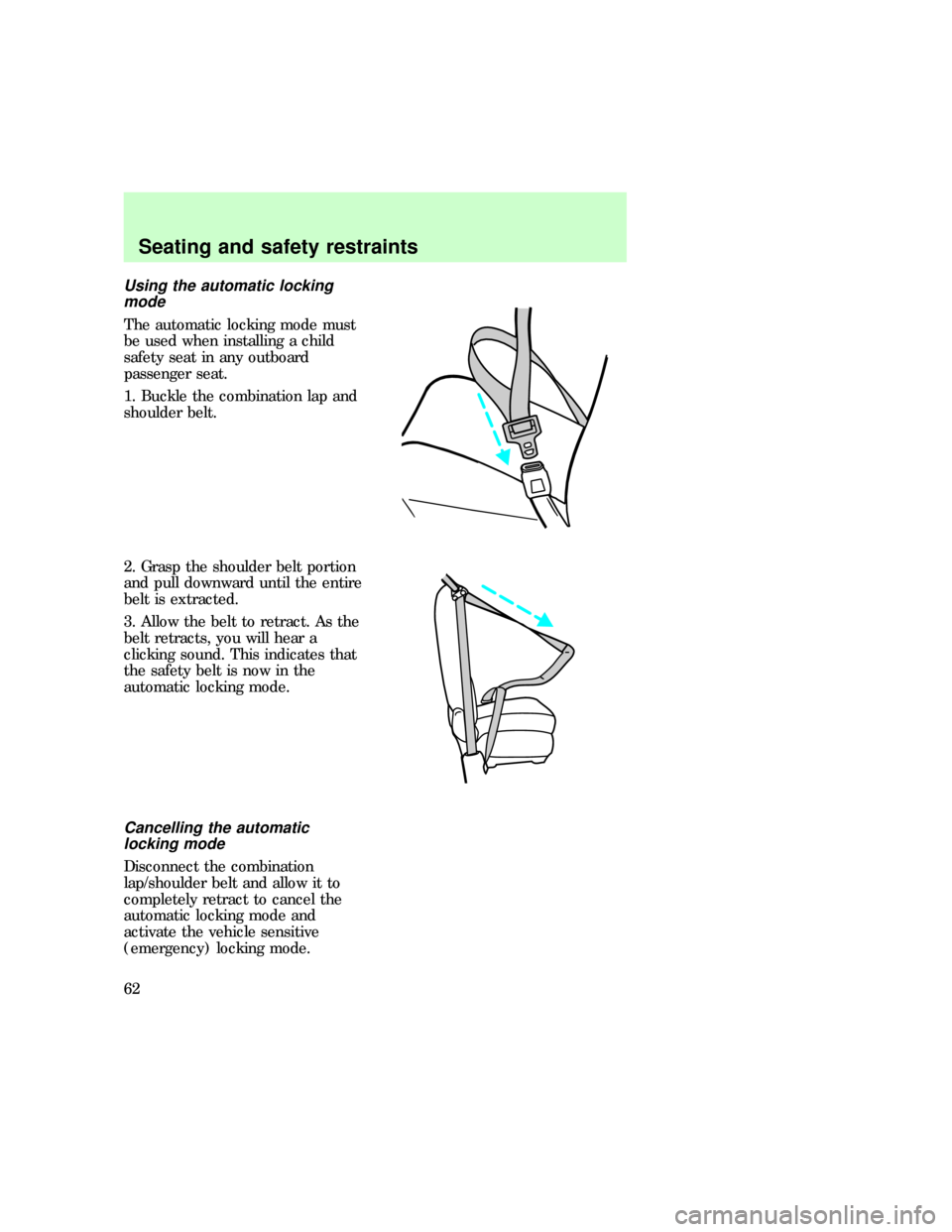
Using the automatic locking
mode
The automatic locking mode must
be used when installing a child
safety seat in any outboard
passenger seat.
1. Buckle the combination lap and
shoulder belt.
2. Grasp the shoulder belt portion
and pull downward until the entire
belt is extracted.
3. Allow the belt to retract. As the
belt retracts, you will hear a
clicking sound. This indicates that
the safety belt is now in the
automatic locking mode.
Cancelling the automatic
locking mode
Disconnect the combination
lap/shoulder belt and allow it to
completely retract to cancel the
automatic locking mode and
activate the vehicle sensitive
(emergency) locking mode.
f12_cancel_alr
f12_front_sbelt_height_adjust
Seating and safety restraints
62
Page 62 of 219
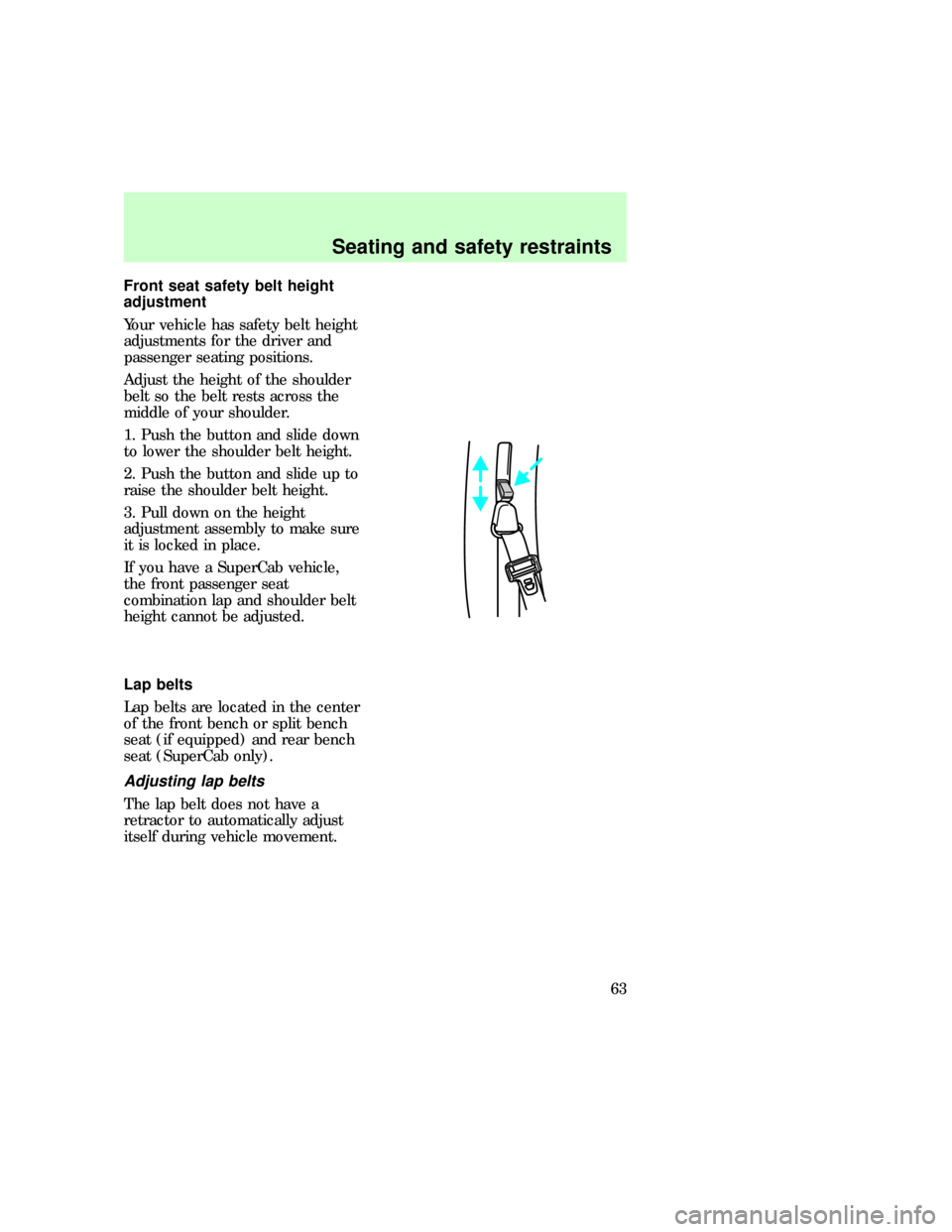
Front seat safety belt height
adjustment
Your vehicle has safety belt height
adjustments for the driver and
passenger seating positions.
Adjust the height of the shoulder
belt so the belt rests across the
middle of your shoulder.
1. Push the button and slide down
to lower the shoulder belt height.
2. Push the button and slide up to
raise the shoulder belt height.
3. Pull down on the height
adjustment assembly to make sure
it is locked in place.
If you have a SuperCab vehicle,
the front passenger seat
combination lap and shoulder belt
height cannot be adjusted.
Lap belts
Lap belts are located in the center
of the front bench or split bench
seat (if equipped) and rear bench
seat (SuperCab only).
Adjusting lap belts
The lap belt does not have a
retractor to automatically adjust
itself during vehicle movement.
f12_lap_belts
f12_adjusting_lap_belts
Seating and safety restraints
63
Page 63 of 219
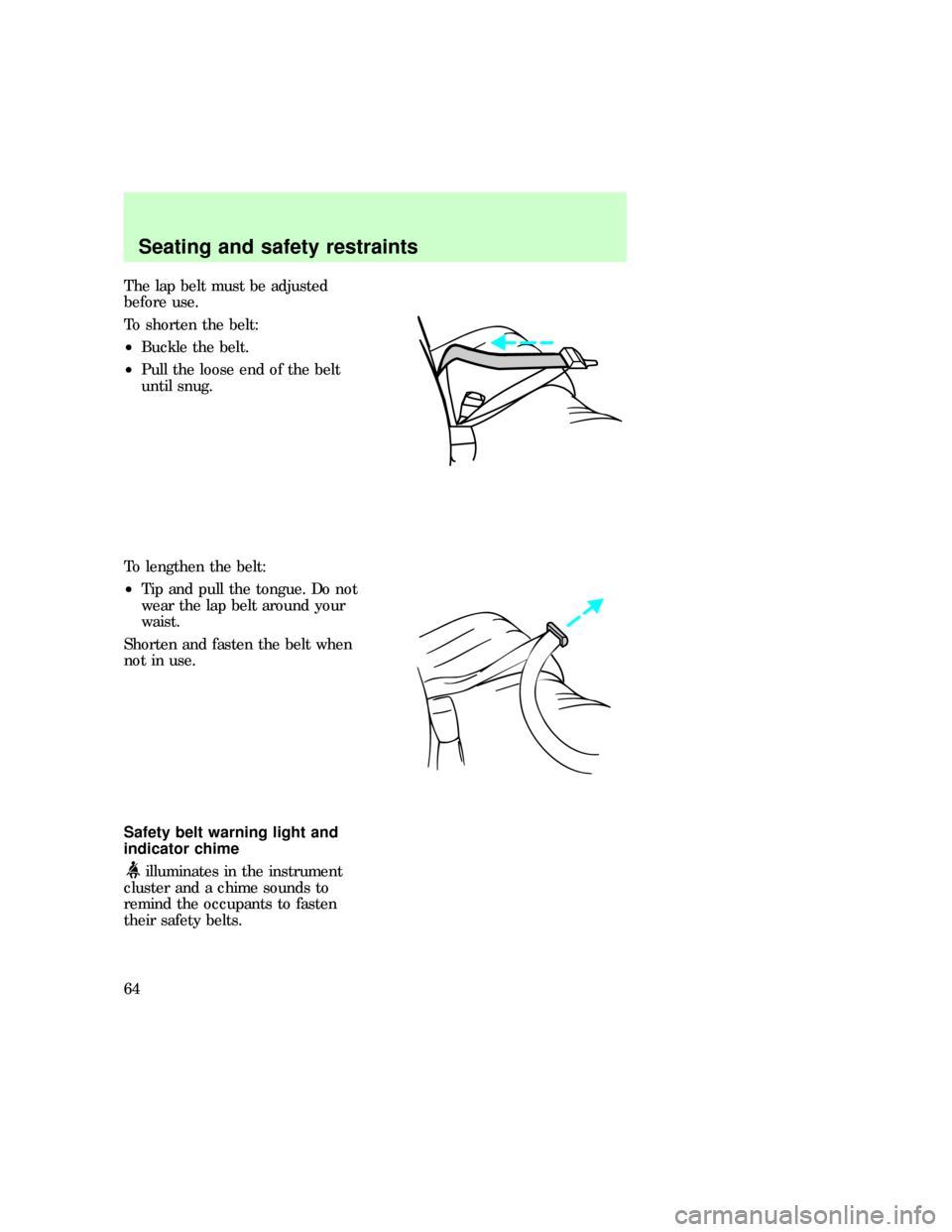
The lap belt must be adjusted
before use.
To shorten the belt:
²Buckle the belt.
²Pull the loose end of the belt
until snug.
To lengthen the belt:
²Tip and pull the tongue. Do not
wear the lap belt around your
waist.
Shorten and fasten the belt when
not in use.
Safety belt warning light and
indicator chime
illuminates in the instrument
cluster and a chime sounds to
remind the occupants to fasten
their safety belts.
f12_sbelt_warning_chime
f12_cond_operation
Seating and safety restraints
64
Page 64 of 219
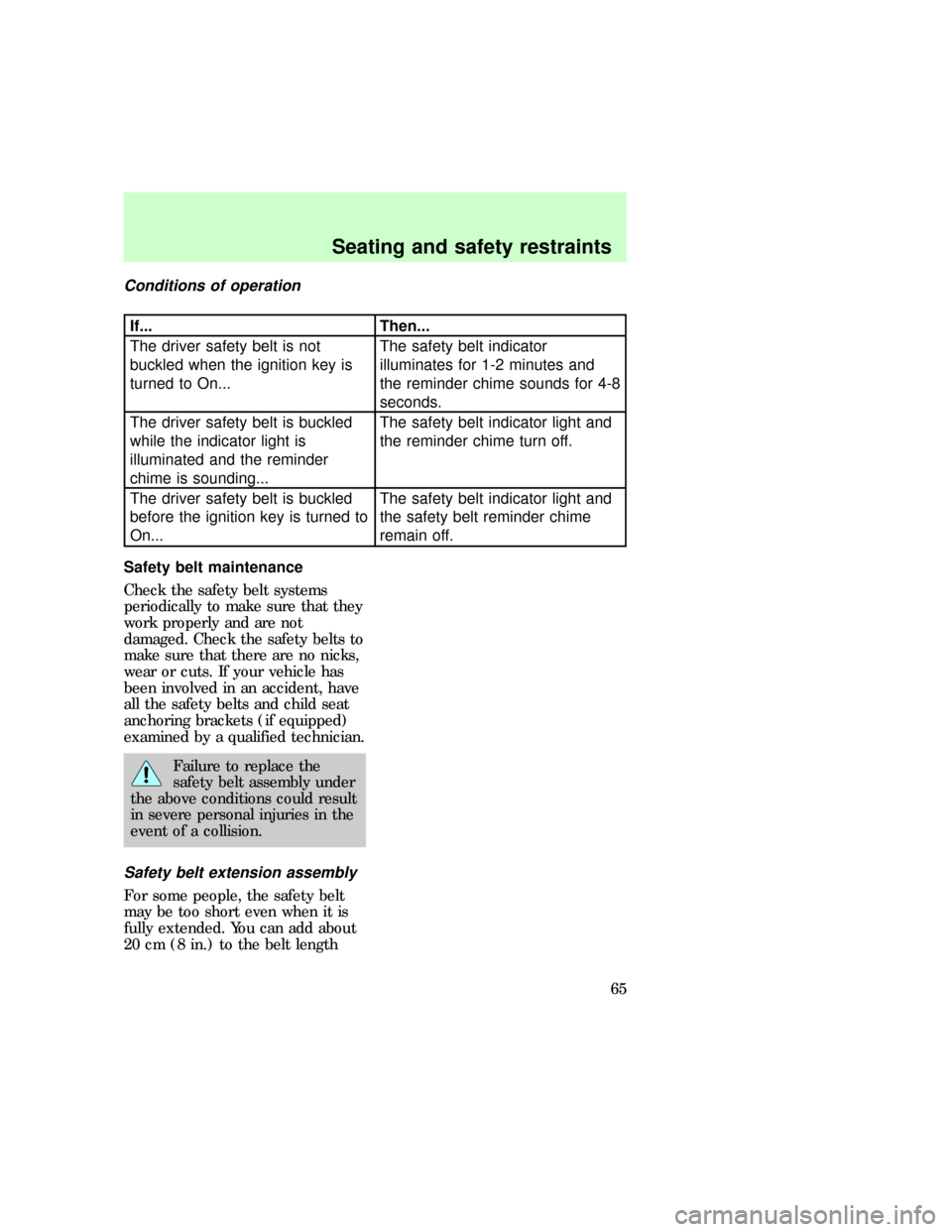
Conditions of operation
If... Then...
The driver safety belt is not
buckled when the ignition key is
turned to On...The safety belt indicator
illuminates for 1-2 minutes and
the reminder chime sounds for 4-8
seconds.
The driver safety belt is buckled
while the indicator light is
illuminated and the reminder
chime is sounding...The safety belt indicator light and
the reminder chime turn off.
The driver safety belt is buckled
before the ignition key is turned to
On...The safety belt indicator light and
the safety belt reminder chime
remain off.
Safety belt maintenance
Check the safety belt systems
periodically to make sure that they
work properly and are not
damaged. Check the safety belts to
make sure that there are no nicks,
wear or cuts. If your vehicle has
been involved in an accident, have
all the safety belts and child seat
anchoring brackets (if equipped)
examined by a qualified technician.
Failure to replace the
safety belt assembly under
the above conditions could result
in severe personal injuries in the
event of a collision.
Safety belt extension assembly
For some people, the safety belt
may be too short even when it is
fully extended. You can add about
20 cm (8 in.) to the belt length
f12_sbelt_maint
f12_sbelt_extension
Seating and safety restraints
65
Page 65 of 219
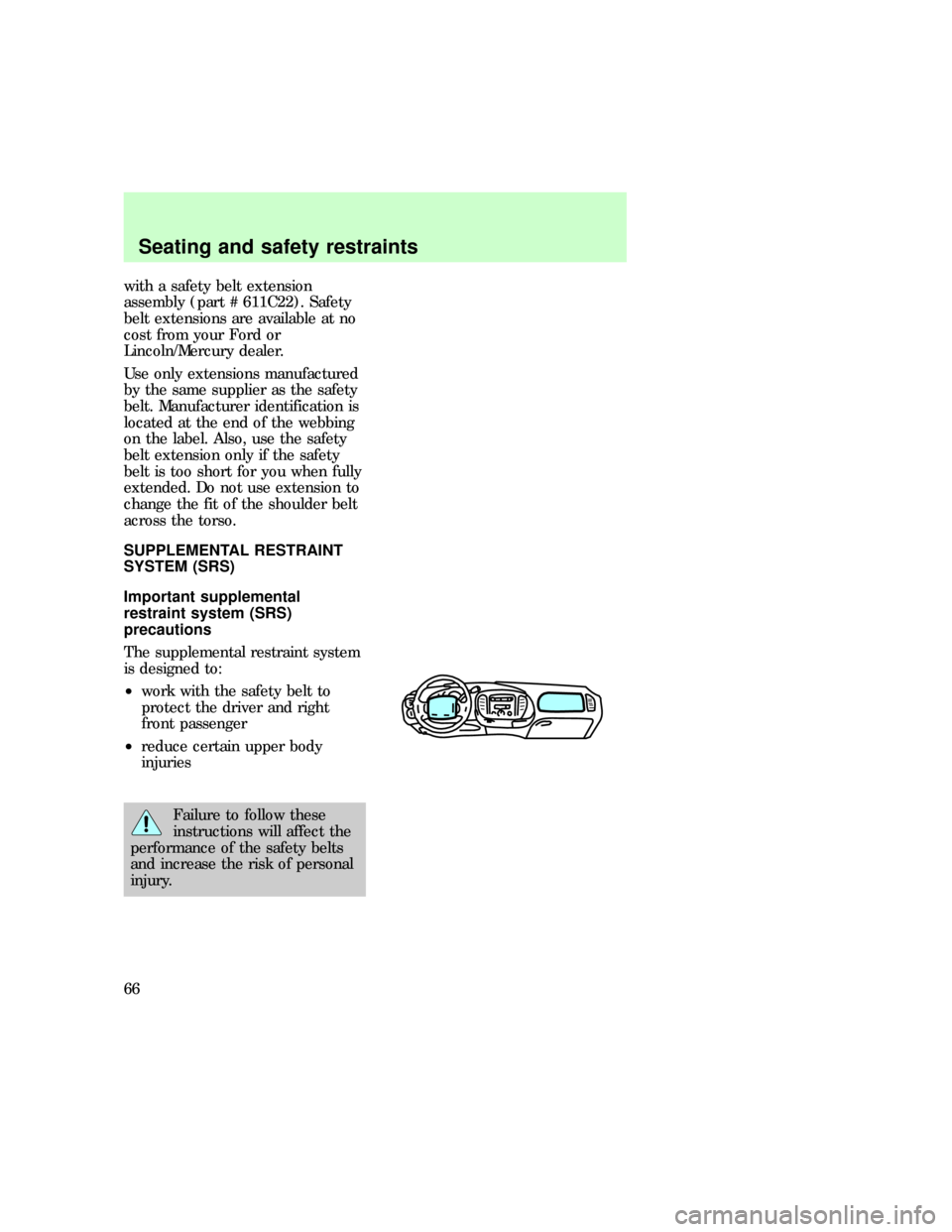
with a safety belt extension
assembly (part # 611C22). Safety
belt extensions are available at no
cost from your Ford or
Lincoln/Mercury dealer.
Use only extensions manufactured
by the same supplier as the safety
belt. Manufacturer identification is
located at the end of the webbing
on the label. Also, use the safety
belt extension only if the safety
belt is too short for you when fully
extended. Do not use extension to
change the fit of the shoulder belt
across the torso.
SUPPLEMENTAL RESTRAINT
SYSTEM (SRS)
Important supplemental
restraint system (SRS)
precautions
The supplemental restraint system
is designed to:
²work with the safety belt to
protect the driver and right
front passenger
²reduce certain upper body
injuries
Failure to follow these
instructions will affect the
performance of the safety belts
and increase the risk of personal
injury.
f12_air_bags
com_important_precautions.01
Seating and safety restraints
66
Page 66 of 219
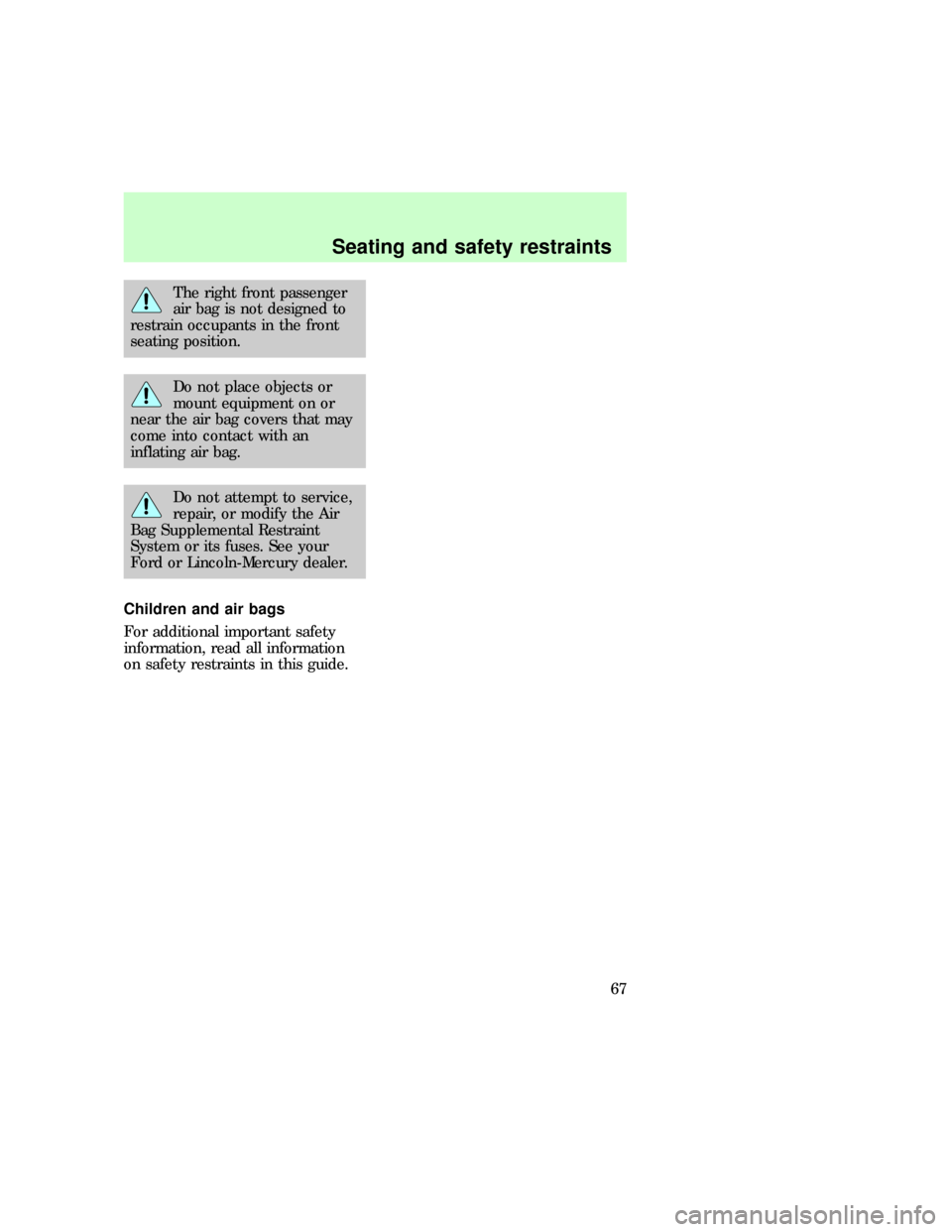
The right front passenger
air bag is not designed to
restrain occupants in the front
seating position.
Do not place objects or
mount equipment on or
near the air bag covers that may
come into contact with an
inflating air bag.
Do not attempt to service,
repair, or modify the Air
Bag Supplemental Restraint
System or its fuses. See your
Ford or Lincoln-Mercury dealer.
Children and air bags
For additional important safety
information, read all information
on safety restraints in this guide.
com_children.01
Seating and safety restraints
67
Page 67 of 219
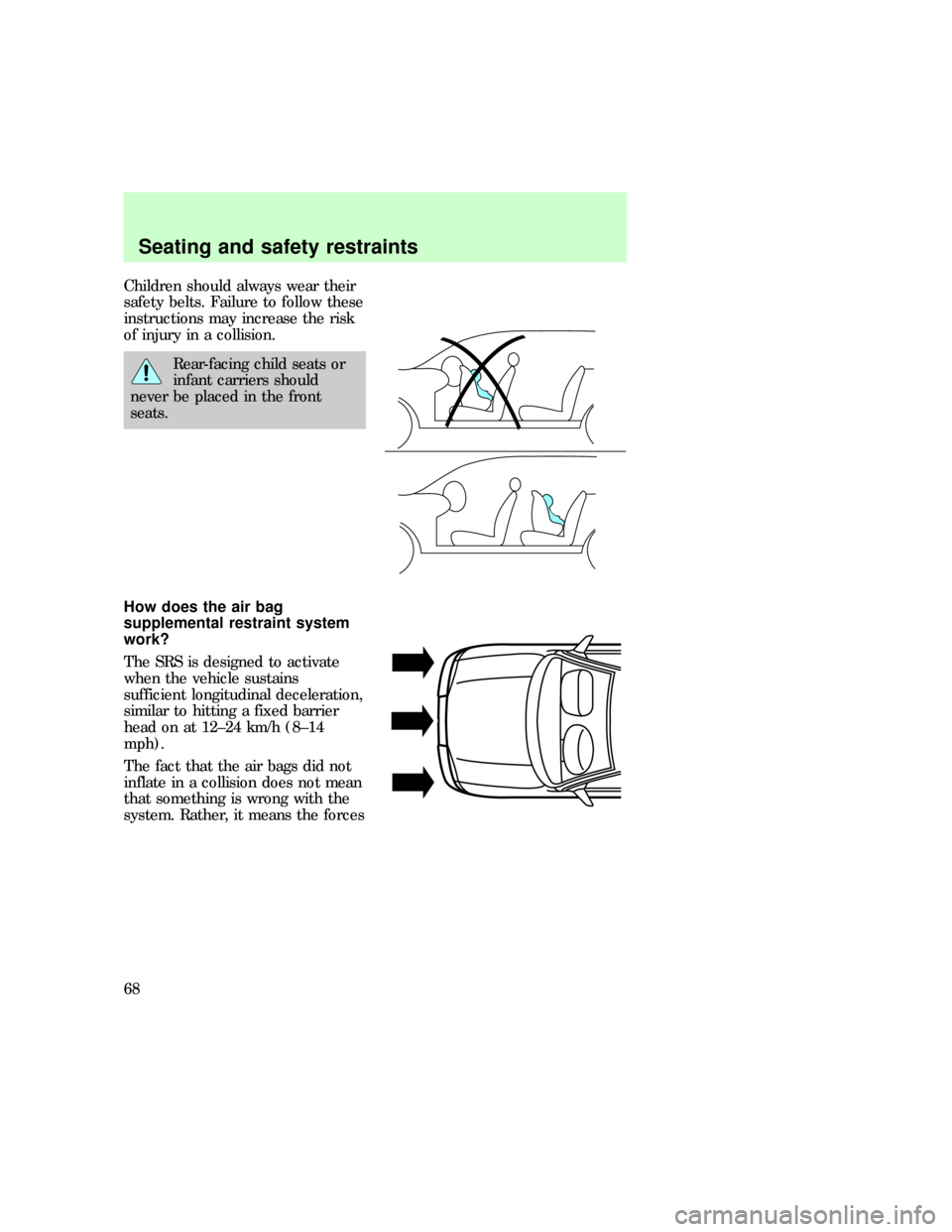
Children should always wear their
safety belts. Failure to follow these
instructions may increase the risk
of injury in a collision.
Rear-facing child seats or
infant carriers should
never be placed in the front
seats.
How does the air bag
supplemental restraint system
work?
The SRS is designed to activate
when the vehicle sustains
sufficient longitudinal deceleration,
similar to hitting a fixed barrier
head on at 12±24 km/h (8±14
mph).
The fact that the air bags did not
inflate in a collision does not mean
that something is wrong with the
system. Rather, it means the forces
com_how_work.01
Seating and safety restraints
68
Page 68 of 219
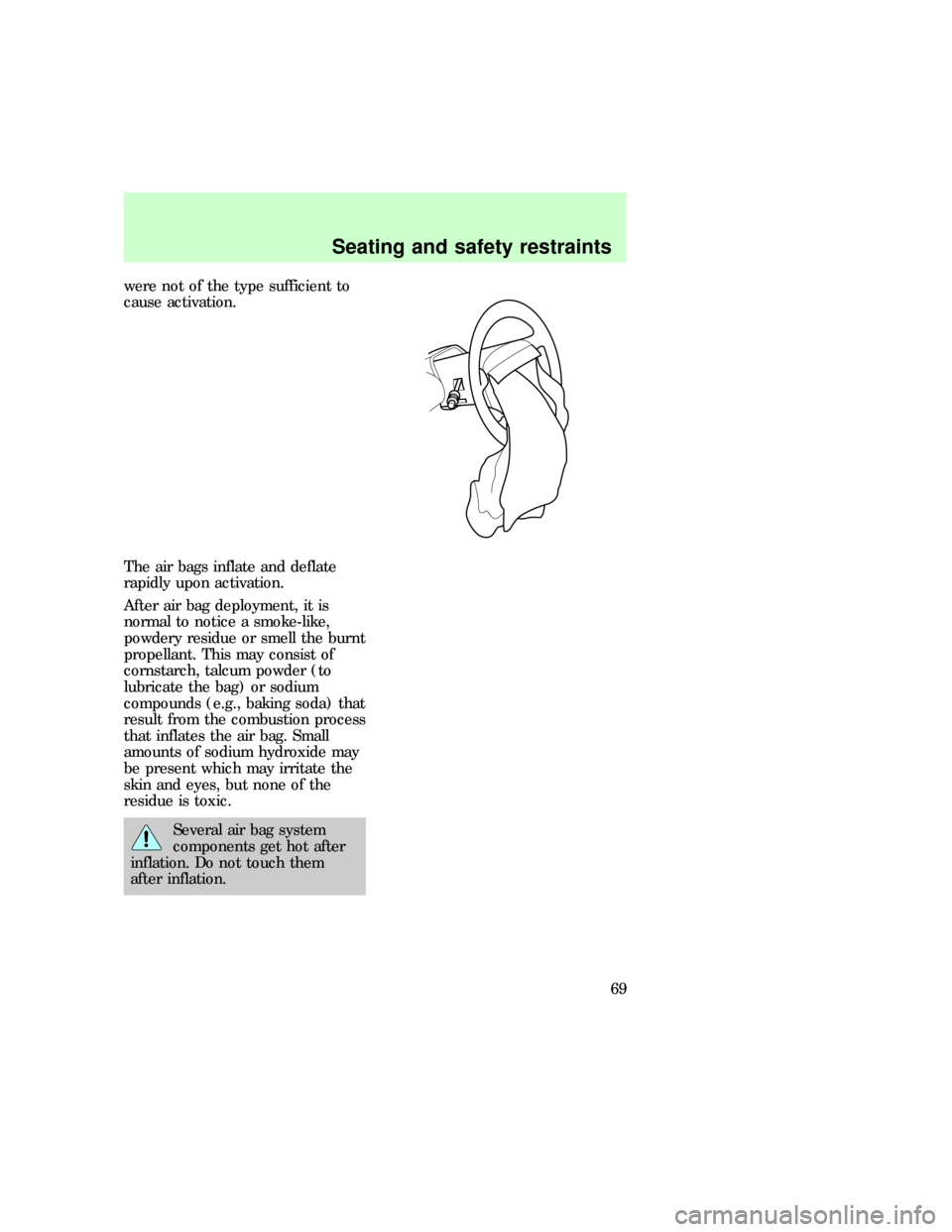
were not of the type sufficient to
cause activation.
The air bags inflate and deflate
rapidly upon activation.
After air bag deployment, it is
normal to notice a smoke-like,
powdery residue or smell the burnt
propellant. This may consist of
cornstarch, talcum powder (to
lubricate the bag) or sodium
compounds (e.g., baking soda) that
result from the combustion process
that inflates the air bag. Small
amounts of sodium hydroxide may
be present which may irritate the
skin and eyes, but none of the
residue is toxic.
Several air bag system
components get hot after
inflation. Do not touch them
after inflation.
Seating and safety restraints
69
Page 69 of 219
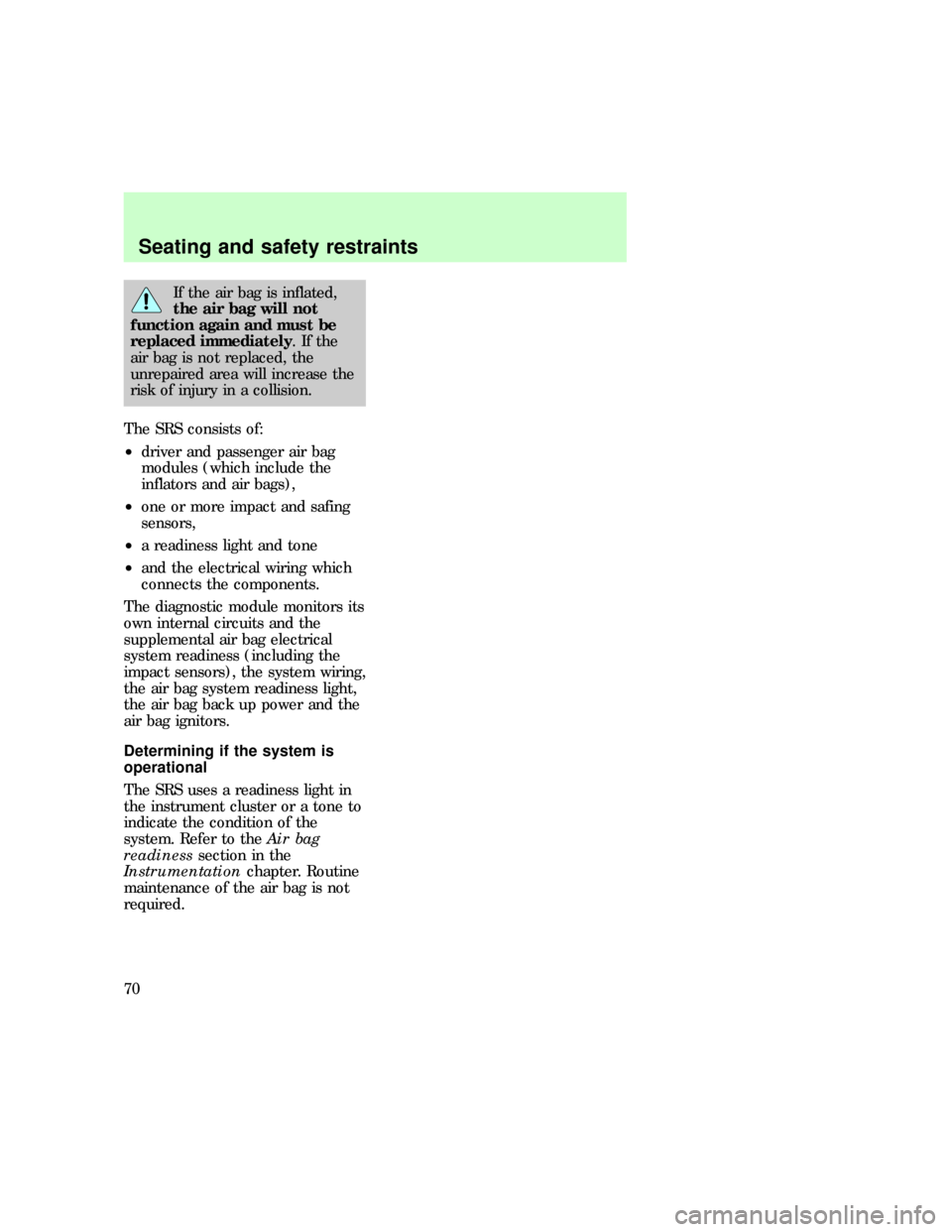
If the air bag is inflated,
the air bag will not
function again and must be
replaced immediately.Ifthe
air bag is not replaced, the
unrepaired area will increase the
risk of injury in a collision.
The SRS consists of:
²driver and passenger air bag
modules (which include the
inflators and air bags),
²one or more impact and safing
sensors,
²a readiness light and tone
²and the electrical wiring which
connects the components.
The diagnostic module monitors its
own internal circuits and the
supplemental air bag electrical
system readiness (including the
impact sensors), the system wiring,
the air bag system readiness light,
the air bag back up power and the
air bag ignitors.
Determining if the system is
operational
The SRS uses a readiness light in
the instrument cluster or a tone to
indicate the condition of the
system. Refer to theAir bag
readinesssection in the
Instrumentationchapter. Routine
maintenance of the air bag is not
required.
com_determing_operational.01
Seating and safety restraints
70
Page 70 of 219
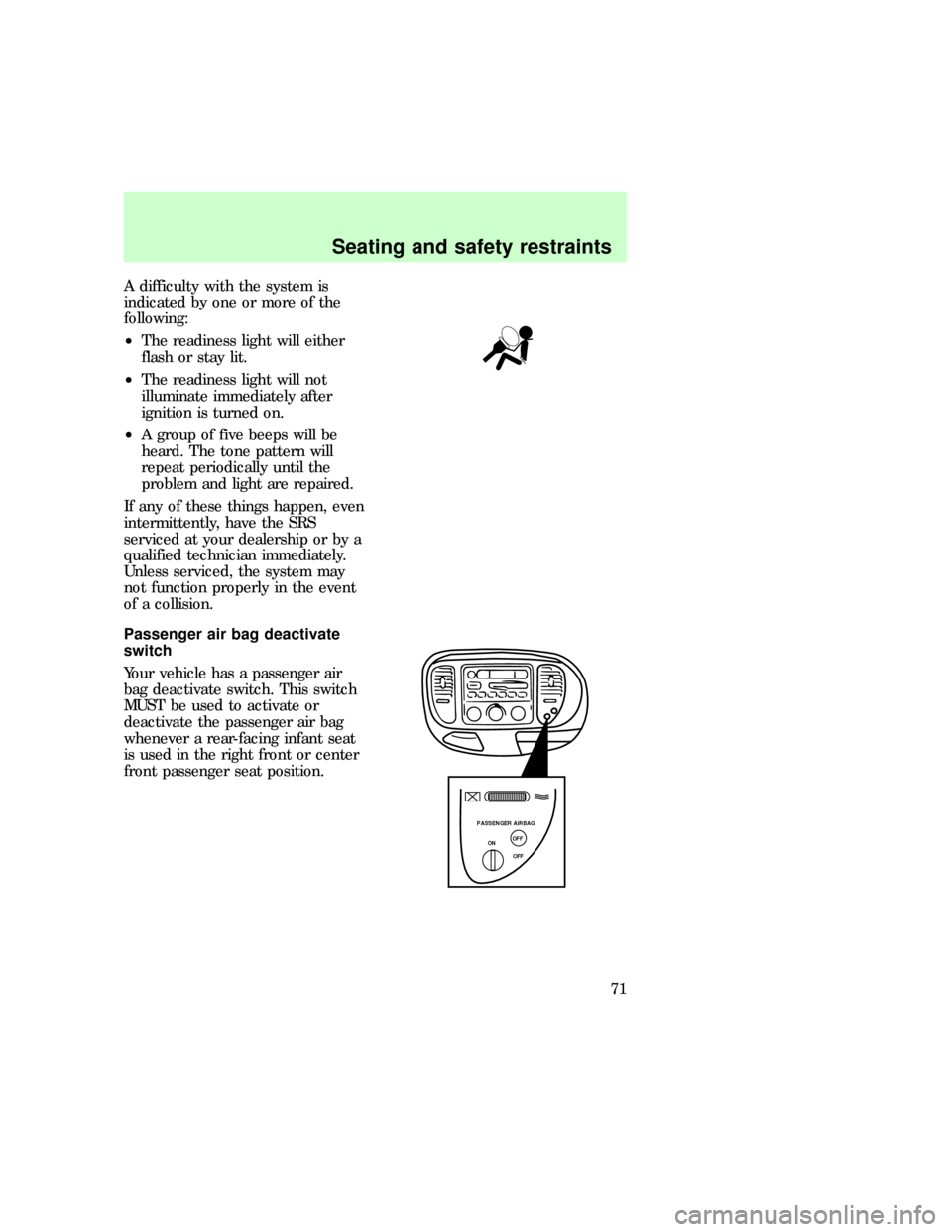
A difficulty with the system is
indicated by one or more of the
following:
²The readiness light will either
flash or stay lit.
²The readiness light will not
illuminate immediately after
ignition is turned on.
²A group of five beeps will be
heard. The tone pattern will
repeat periodically until the
problem and light are repaired.
If any of these things happen, even
intermittently, have the SRS
serviced at your dealership or by a
qualified technician immediately.
Unless serviced, the system may
not function properly in the event
of a collision.
Passenger air bag deactivate
switch
Your vehicle has a passenger air
bag deactivate switch. This switch
MUST be used to activate or
deactivate the passenger air bag
whenever a rear-facing infant seat
is used in the right front or center
front passenger seat position.
PASSENGER AIRBAG
ON
OFF OFF
f12_srs_deactivate
Seating and safety restraints
71